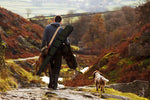¿Qué equipo de caza necesito?
- 3 min tiempo de lectura

Sé lo que podrías estar pensando: “Esto es demasiado básico. Ya sé esto.” Muchas veces, lo básico se pasa por alto fácilmente, y solo porque lo hagas de una manera no significa que no puedas obtener ideas de otra persona.
Aquí tienes una lista de lo que necesitarás llevar basada en mis años de experiencia.
Mochila de caza
Además de tus botas y arma, esta es la pieza de equipo más importante que necesitarás. Es la base del equipo ya que se usa para soportar (llevar) todo lo demás. También dependerás de tu mochila para ayudar a transportar la abundante cosecha fuera de la montaña. Debe ser cómoda para usar todo el día cargando equipo y lo suficientemente resistente para el posible transporte. Debe tener un armazón interno o externo para soportar cargas pesadas, así como un sistema de suspensión bien acolchado. De este sistema de suspensión, el cinturón de cadera es la pieza más importante. Aquí es donde debe ir aproximadamente el 80% del peso que llevas en la mochila. Las correas de los hombros son menos importantes y deben estar cómodamente acolchadas y moldeadas para que no se claven en tu cuello o hombros.
Elige una mochila con muchos bolsillos para mantener el equipo organizado y guardado.

Kit de sacrificio
Esto será esencial cuando hayas hecho un disparo bien colocado y ético en ese ciervo mula macho, y él expire antes de tocar el suelo. Todo el equipo requerido debe mantenerse en una bolsa organizadora de equipo. Ver abajo:
Etiquetas/Licencia (deben estar siempre con el kit de sacrificio o en un bolsillo específico de tu mochila)
Cuchillo afilado (ya sea de hoja fija o intercambiable)
25 pies de paracord
Guantes de goma
Bolsas para carne de buena calidad y livianas (5)
Bolsa de basura tamaño contratista o lona sintética
Toallitas húmedas
Equipo esencial de caza
¿Puedes responder positivamente ante un accidente o emergencia?
¿Puedes pasar la noche de forma segura si es necesario?
Nunca entres al campo sin ellos.
Navegación: mapa topográfico en papel, aplicación BaseMap en el teléfono con mapas precargados de un radio de 10 millas, comunicador satelital
Linterna frontal con baterías extra
Botiquín de primeros auxilios incluyendo cuidado para ampollas
Kit de fuego
Cerillas impermeables en un pequeño contenedor
Bolas de algodón empapadas en vaselina
Toallitas Rem Oil (excelente para iniciar fuego)
Encendedor de butano impermeable
La multiherramienta más ligera que puedas encontrar
Bálsamo labial, protector solar y gafas de sol
Depósito de agua de 1.5 a 3 litros o botella Nalgene de 32 oz
Filtro de agua y tabletas de yodo (respaldo)
Bivvy ligero de emergencia
Comida: lleva suficiente para un día completo si desayunas en el campamento. Si no desayunas en el campamento, lleva comida para un día y un desayuno por si tienes que pasar la noche
Chaqueta acolchada
Ropa ligera para lluvia si el clima anuncia chubascos (mantén a mano en el campamento si no)
Papel higiénico
Otro equipo (para llevar)
Telescopio de observación (opcional)
Arma de elección más munición
Indicador de viento
Bastones de trekking con cinta adhesiva envuelta en uno y cinta aislante en el otro
Almohadilla para culata o silla pequeña enrollable

Sistema de capas de ropa
Prenda interior de merino para la piel, superior e inferior (según la temperatura)
Pantalones duraderos pero cómodos
Sudadera con capucha de merino
Chaleco
Chaqueta
Polainas
Guantes de merino
Gorro
Bufanda tubular
Buenas botas (esencial)
El sistema de capas es clave cuando cazas, consiste en una buena combinación de caminata y estar sentado/observando.
Hay muchas opciones para elegir al seleccionar el equipo con el que cazarás. Investiga y simplemente ve qué funciona para ti. Además, aparte de lo esencial, si no uso algo en dos viajes consecutivos, lo quito de la lista de equipo para el próximo viaje.
Etiquetas
Featured collection
Blog posts
-

, por ZW CVLIFE Top AR-15 Optic Mistakes Hunters Still Make
-

, por ZW CVLIFE 5 Best AR-15 Scopes: How to Choose Right Optic for Your Rifle
-

, por C V Tu mira para AR-15 no es el problema — tu montura lo es
-

, por C V 🧐 Pensé que mi punto rojo estaba calibrado... Luego probé esto












